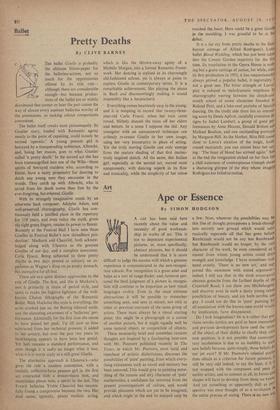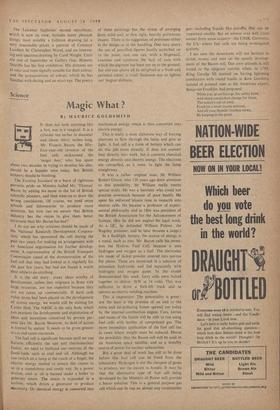Art
Ape or Essence
By SIMON HODGSON
A LOT has been said here recently about the value and necessity of good workman- ship in works of art. This is not to deprecate experimental pictures, or, more specifically, abstract pictures, but it should be understood that it is more difficult to judge the success with which a genuine experience is communicated in the non-recogni- tion schools. For recognition is a great asset and helps as a sort of range-finder; and, however per- sonal the final judgment of a picture is, recogni- tion will continue to be important as new visual languages evolve. Even in the most extreme abstractions it will be possible to remember something seen, and seen in nature, not only in other or previous canvases of the same group of artists. There must always be a visual starting point; this might be a photograph or a corner of another picture, but it might equally well be some natural object, or conjunction of objects.
These necessarily brief and somewhat random thoughts are inspired by a fascinating interview with Mr. Pasmore published recently in The Times, in which Mr. Pasmore, most lucid and trenchant of artistic dialecticians, discusses the possibilities of 'pure' painting, from which every- thing extraneous such as mood and memory has been removed. This would give to painting some- thing of the remote and airy character of 'pure' mathematics, a usefulness far removed from the present preoccupations of culture, and would provide pleasures which are yet to be imagined, and which might in the end be enjoyed only by a few. Now, whatever the possibilities may be, this line of thought presupposes a break-through into entirely new ground which would auto' matically supersede all that has gone before, Rembrandt would not be any less Rembrandt, but Rembrandt would no longer, by the very character of his work, be even considered as a master from whom young artists could dray' strength and knowledge. I have sometimes mut' tered crossly, 'There is no new art,' and suP' ported this statement with sound argument–' indeed I still say that in the most avant-garde • abstract gouache from the farthest depths of the Cromwell Road, I can show you Michelangelo, and discover even in such a dusty young talent possibilities of beauty, and joy both terrible and gay. I could not do this in 'pure' painting for all association with the known seen world would, by implication, have disappeared.
Do I lack imagination? Or is it rather that pre' vious revolts (critics are paid to have memories) and previous developments have used the tern's of the object of their dislike to clarify their ove new position; is it not possible that contemPa' rary incoherence is due to an inability to state new beliefs because, quite simply, those beliefs do not yet exist? If Mr. Pasmore's celestial purity does obtain as a criterion for future painters, It will be very odd indeed, to say the least, if it not mapped with the compasses and pens ot earlier artists; and to connect at all, its forms and shapes will have to develop from those we knoW• And yet something as apparently dull as per' spective was once thought of as a revolution Iss the entire process of seeing. There is no new art'
The Leicester Galleries' second miscellany, which is now on view, includes many pleasant things, most notably a Gillman drawing (at a very reasonable price), a portrait of Constant Lambert by Christopher Wood, and an interest- ing and spacious drawing by Carel Weight. Until the end of September at Gallery One, Hussein Shariffe has his first exhibition. His pictures are at once and most signally notable for their colour, and the juxtapositions of colour, which he has handled with daring and an exact eye. The poetry of these paintings has the virtue of emerging from solid and, at first sight, heavily portentous shapes. There is no suggestion of prettiness either in the design or in the handling. One may query the use of pencilled figures hastily scratched on to the paint, and one can, with a fingernail, examine and condemn the lack of care with which the pigment has been put on to the ground; but one can above all be delighted at a fresh and personal talent, a small Sudanese sun to lighten our August dullness.















































 Previous page
Previous page